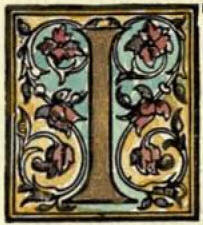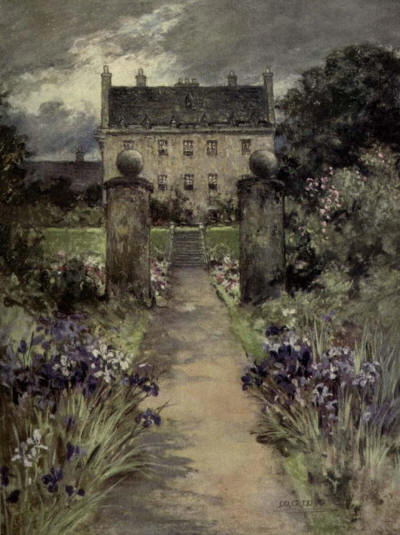|
 T
would be difficult, if not impossible, to find a more characteristic
example of Scottish domestic architecture of the sixteenth and
seventeenth centuries than that presented in the old house of Carnock.
Originally built in 1548 by Sir Robert Drummond, whose arms and
initials, with those of his wife, Margaret Elphinstone of Dunmore, still
remain over the principal entrance, it was added to in 1634 when the
property was acquired by Sir Thomas Nicolson, and remains unchanged in
its main features, though outbuildings and offices have been erected to
adapt the dwelling to the requirements of a modern household. T
would be difficult, if not impossible, to find a more characteristic
example of Scottish domestic architecture of the sixteenth and
seventeenth centuries than that presented in the old house of Carnock.
Originally built in 1548 by Sir Robert Drummond, whose arms and
initials, with those of his wife, Margaret Elphinstone of Dunmore, still
remain over the principal entrance, it was added to in 1634 when the
property was acquired by Sir Thomas Nicolson, and remains unchanged in
its main features, though outbuildings and offices have been erected to
adapt the dwelling to the requirements of a modern household.
"What Messrs. M`Gibbon
and Ross, a distance," observed "has been travelled over in the three
centuries which have elapsed from the time when Scottish nobles were
content to live in towers containing three apartments only —a ground
floor for cattle, a first floor for a hall in which the retainers lived
and slept, and a top storey for the lord and his family! The
introduction of a kitchen was at first hailed as an important innovation
and improvement, all provisions having been previously cooked in the
hall or in the open air. But in the seventeenth century people have
become so refined that the kitchen, with what was formerly considered
its sweet perfumery, must be banished out of doors. The domestics are
now quite separated from the hall, while the proprietor and his family,
no longer huddled up in one room, enjoy the delights of the modern
dining-room and drawing-room, private sitting-rooms and bedrooms, all
provided with separate doors." [astellated and Domestic Architecture of
Scotland, ii. 496.]

Those who sigh for the
good old times and repine because their lot was not cast "in days of old
when knights were bold," may incline to think that the domestic
discomfort of a sixteenth century Scottish mansion is exaggerated in the
passage above-quoted. They may agree that the knight and his family
dined at the same table with the servants; what could be more
picturesque and in keeping with feudal custom? But surely the lady had
her bower, where she worked embroidery with her maidens, while a pretty
page or sadly attired clerk read aloud some romaunt of chivalry—say the
stirring adventures of Ferambras and Oliver or the story of Sir Eglamour
of Artois. She would also have her parterres, spending much of her time
in tending her favourite flowers. Alas! if you would learn the naked
truth from an eye-witness, hear how Fynes Moryson described his
entertainment in a Scottish country house of the seventeenth century.
"My self was at a
Knight's house, who had many servants to attend him, that brought in his
meate with their heads covered with blew caps, the Table being more then
halfe furnished with great platters of porredge, each having a little
peece of sodden meate; And when the Table was served, the servants did
sit downe with us, but the upper messe in steede of porredge, had a
Pullet with some prunes in the broth. And I observed no Art of Cookery,
or furniture of Houshold stuffe, but rather rude neglect of both, though
my selfe and my companion, sent from the Governour of Barwicke about
bordering affaires, were entertained after their best manner. . . .
Their bedsteads were like Cubbards in the wall, with doores to be opened
and shut at pleasure, so as we climbed up to our beds. They use but one
sheete, open at the sides and top, but close at the feete, and so
doubled." [Itinerary, iv. 183 [ed. 1908]. Moryson's visit to Scotland
took place between 1606 and 1617.]
It may well be imagined
that, luxury being so scant within doors, little care was bestowed in
furnishing the garden with anything except kitchen stuff; but when I was
last at Carnock ample amends had been made in that respect by the lady
of the castle, who is an enthusiastic gardener. The property passed to
the Shaw Stewarts by marriage in the eighteenth century; the present Sir
Hugh and Lady Alice lived at Carnock till he succeeded his father in
1903, when they moved to Ardgowan and let the old house. I know not what
may be the appearance of that garden now, but half-a-dozen years ago it
was a joy to behold. Every border overflowed with blossom; alpine Erinus,
saxifrages and other clinging herbs clustered in crevices of the old
walls and in the chinks of the broad stone steps on the terrace front.
There was abundance and luxuriance of Christmas roses such as one may
seldom enjoy; for the purpose of this garden was not to produce a
culminating blaze at the end of the London season, such as was deemed
the acme of mid-Victorian horticulture, but to link season with season
and month with month by a succession of blossom. No flower is more
important to this scheme than the varieties of Helleborus niger. The
torch lilies have not quenched their flames nor the late asters their
stars before the variety called maximus or altifolius unfurls its great
blooms, tinted like apple-blossom, to be followed about Christmastide by
major, Madame Fourcade, angstifolius and others, which choose the
darkest, dreariest time of the whole year for their display, and keep
things going till snowdrops, aconites and crocus strike the first chord
in the overture of another year.
Simple as the
requirements of Christmas roses, it is a fact that failures are more
frequent than success in its cultivation. Many an amateur, delighted
with the rare sight of a mass of ivory blooms, rose-tinted on the backs,
resolves to have the like in his own garden, so that Christmas roses
ought to be as commonly seen in good condition as double daisies or
daffodils. But they are not: a luxuriant bank of Hellebore niger is one
of the rarest sights in horticulture. I have been gardening for forty
years and more, yet have never yet succeeded to my liking with these
charming flowers. Coming, coming, coming—but never yet come. Yet we are
assured that all they want is deep loam, partial shade and to be let
alone. One precaution must not be neglected in gardens where pheasants
come—namely, to surround the bed with wire-netting before they come into
flower, else will these greedy birds nip off every bud. [I leave this as
it was written after my last visit to Carnock, because I feel sure that
my experience has its parallel in that of many other amateurs. But in
the paper on Balcaekie (p. 149) I have described how Mr. Maule, the
gardener there, instructed me in the right management and propagation of
hellebore.] |

